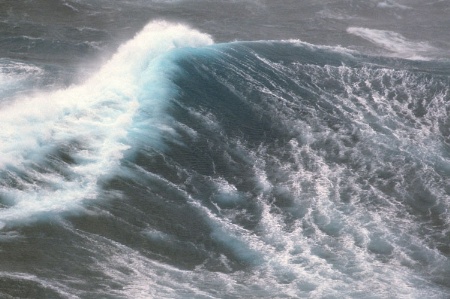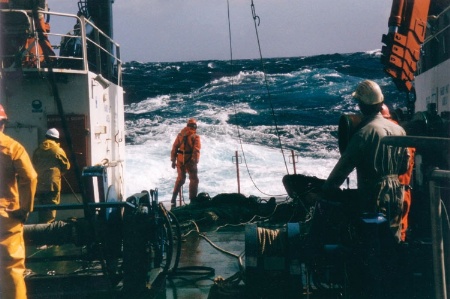It was a dangerous situation and, apart from the damage to the ship, people were hurt. I am hoping something like that never comes up again
When a porthole in the Royal Research Ship Discovery shattered one stormy February night in the North Atlantic 13 years ago, oceanographer Penny Holliday took it as a plea for mercy by the 38-year-old vessel to the mountainous waves.
But she also knew there was nothing its professional crew could do to bring the veteran ship relief. Any attempt to flee the storm could end in disaster if the waves hit the Discovery (named after the vessel that had taken Scott and Shackleton on their first, successful mission to the Antarctic) side on. The only option was to continue pointing the ship’s bow into the oncoming tempest (known as “heaving to”) and wait for it to subside.
It could be said that Holliday, a senior scientist at the Natural Environment Research Council’s National Oceanography Centre in Southampton, was, at least to some extent, the author of her own – and the ship’s – predicament.
Oceanographers had been monitoring the same stretch of ocean between Scotland and Iceland on an annual basis since 1975, but Holliday was conscious that most of the existing data, relating to currents, temperature and salinity, had been collected during the summer.
“Winter is an interesting time in the North Atlantic because lots of the heat the ocean contains is released into the atmosphere, and this is the process that keeps the UK warmer than Canada or other places on an equivalent latitude,” she says.
“I was young and inexperienced, so I thought: ‘Hey, we should go out in winter.’ It turned out to be a bit of a mistake.”
Not that Holliday – who was the principal scientist on the cruise – was under any illusions about what kind of weather to expect in February in a body of water “right in the middle of the path of the main Atlantic storms”. But she was reassured that Nerc’s ships were “very safe” and could operate in “pretty rough conditions”. And even the worst storms typically do not endure for more than 24 hours or so, after which “the sea starts to calm down quite quickly” and scientific work can resume.
However, on this occasion Holliday and her colleagues were confined below decks for five solid days as a seemingly never-ending procession of deep, active depressions swept through the area, whipping the waves higher and higher, deeper and deeper until one reached a staggering 29.1m from peak to trough, according to the Discovery’s equipment: the equivalent of a 10-storey building.
“You have probably seen pictures of surfing waves breaking on to land at that height, but in the open ocean it is almost unimaginable,” Holliday says.

“Scientists have something called ‘significant wave height’, which is a statistical measure of a wave field – not just individual waves. An old-fashioned definition is that it is the average height of the biggest 30 per cent of the waves. Our measurement was 18.5m, which is the largest ever recorded.”
By this point, all the scientists on board had their sea legs, so seasickness was not a problem. But such were the enormous rolls the ship was making that some of the scientists sustained injuries, among the most common being broken ribs sustained in collisions with sinks as they were tossed about.
The shattering of the amidships porthole – not to mention all the “creaking and groaning” – indicated to Holliday how much strain the Discovery was under, twisting as each wave hit. She was also aware that the vessel had been extended in the early 1990s by being sliced in half and having an extra 10m of hull inserted into the gap.
“I was thinking: ‘I really hope they did a good job of that welding!’” she says.
But it was only several years later that she learned from one of the crew just how close they had all come to disaster. A 33º roll had caused one of Discovery’s lifeboats to come loose from its fittings and it started slamming into the vessel’s side. All hands apart from the captain bravely donned safety harnesses and went out on deck to try to secure it. Their efforts were successful but, during their absence, the skipper was unable to leave the wheel and check the radar on the console behind him. He became aware of an approaching fishing boat only when it loomed out of the spray and early morning darkness, heading straight for them.
“He reacted very quickly and adjusted our heading very slightly, so the trawler passed about 20m down our port side. If we had hit it that would have been the end of all of us, I would think. I’m really glad I didn’t know about it at the time.”
As it was, although she admits the experience was “quite frightening” as well as gruelling (sleep being very difficult in such conditions), she had faith in the safety of the ship and the professionalism of its crew. Holliday says that her principal emotion was frustration, as she could not get on with the science she had set out to do.
Scientific cruises normally involve round-the-clock data collection, carried out by teams in different shifts, or “watches”. Each individual typically works one eight-hour shift per day and fits in an additional four hours “in between staring at the horizon, going to the gym or having lunch”.
The work involves collecting water samples and harvesting data from instruments lowered over the ship’s side, then running the information through software. Holliday admits that these tasks are very repetitive and “one day can feel very much like another”. But all of the tedium is swept away when “you see the Northern Lights or whales or, in the southern ocean, penguins and icebergs. These things are fantastically exciting.”

Although she says that calling the trips ‘cruises’ is misleading ‘because it implies bars and pools and things’, she describes Nerc’s ships as ‘comfortable’
Indeed, for Holliday, her once-annual cruise – typically lasting between three and six weeks – is one of the perks of being an oceanographer, even if it isn’t the reason she entered the field.
“There was a period between 2004 and 2010 when I didn’t go to sea because I had two young children, and I really missed it. It was a great moment when I could go back again,” she says. “You go to amazing places and see amazing things.”
Although she says that calling the trips “cruises” is misleading “because it implies bars and pools and things”, she describes Nerc ships as “very comfortable”. Along with a “small” gym, they also include libraries and video rooms, and while bathrooms are shared between two people, everyone has their own cabin and the food is “excellent”.
“We are very well looked after by the guys who work on the ship,” she says.
Holliday has faced plenty of storms since that tempest in both the North Atlantic and the Southern Ocean, but nothing so prolonged or with such colossal waves. Partly this is a result of advances in wind and wave forecasting, which have made it much easier for ships to steam away before the worst of the weather arrives.
“Our ships regularly submit weather reports [which] feed into…forecasts and, in 2000, we could see the forecasting changing as a result of our data. But they never forecast the level of weather we actually had,” she says.
By contrast, her most recent cruise, in May, which traversed the same area of the North Atlantic, benefited from “spot-on” forecasts: “This meant we could plan our working around the area to avoid the worst of the waves and we lost hardly any time.”
But the other reason she has avoided a repeat is that she has not gone on a winter cruise since. The Discovery, which was finally withdrawn from service this year, was so battered by the monster waves that it was deemed too risky to send it out in the North Atlantic in winter again. Holliday was not quite so scarred by the experience, but she admits it has made her “think twice” about sailing with any research ship in that season, which is partly why she has not done so since.
“It was a dangerous situation and, apart from the considerable damage to the ship, people were hurt. I am hoping something like that never comes up again,” she says.
Register to continue
Why register?
- Registration is free and only takes a moment
- Once registered, you can read 3 articles a month
- Sign up for our newsletter
Subscribe
Or subscribe for unlimited access to:
- Unlimited access to news, views, insights & reviews
- Digital editions
- Digital access to THE’s university and college rankings analysis
Already registered or a current subscriber? Login





